If you haven’t noticed, the folding knife market is hopping. Doing a quick online search will bring up discount specials for a few bucks and heirloom blades priced in the hundreds. You can find specialized folding knives for just about any task you can think of and manufacturers are getting creative with the kinds of materials they use.
We devote a lot of attention to tactical equipment here at Task & Purpose, but we know our readers have an eye toward the great outdoors, too. When training ranges and plate carriers are replaced by national wilderness areas and flannel shirts, it’s not a bad idea to leave the serrated tanto blade at home.
Much like the great and wise Earl Dibbles, Jr., I’m a bit of a country boy at heart. I fix the tree, whittle sticks, and if I had a barbed wire tattoo (that went all the way around), it would definitely get me chicks. I’ve done enough hunting and cut enough calves to appreciate a knife that opens with one hand the instant I need it, makes a clean cut, and stays sharp even when there isn’t time to baby it.
Benchmade’s North Fork folding knife appears––at least on the product page of their website––to check all those boxes. It’s marketed as a hunting knife for your pocket. Supposedly it crosses the divide between full-sized fixed blades and the EDC that you’re probably carrying right now. By that logic, it should compete with knives like the Buck 303 Cadet just as well as the Spyderco Delica 4.
Benchmade must be pretty proud of the North Fork, because the MSRP of $190 is far beyond what most folding knives cost. There are plenty of serviceable options available for around $50, so there better be something about the materials, design, or capabilities that justifies such a premium. About the only more expensive folding knives are high-end offerings from brands like Spyderco and boutique blades from Helle, Santa Fe Stoneworks, and the like. People shopping the North Fork will need to have an appreciation for products that go the extra mile if they’re going to spend that kind of money.
That sounded good to me, so I got my hands on one to find out for myself whether or not it’s the real deal.
Blade length: 2.97 in
Weight: 3.16oz
Material: CPM-S30V steel (blade), Dymondwood (handle)
Unboxing
I’ve seen so many knives at this point in my life that it’s pretty tough for one to grab my attention. But that’s what the Benchmade North Fork did when I opened the box and shook it out of its soft drawstring bag.
“Oh,” I thought to myself. “This looks nice.”
The contrast of dark wood grain and stainless steel was striking. Wood certainly isn’t the most durable choice for a knife handle (as we’ll get to later), but this one is actually an engineered product called Dymondwood, which manages to retain the beauty and natural appearance of hardwood while adding the strength and weather-resistance of a plastic composite.
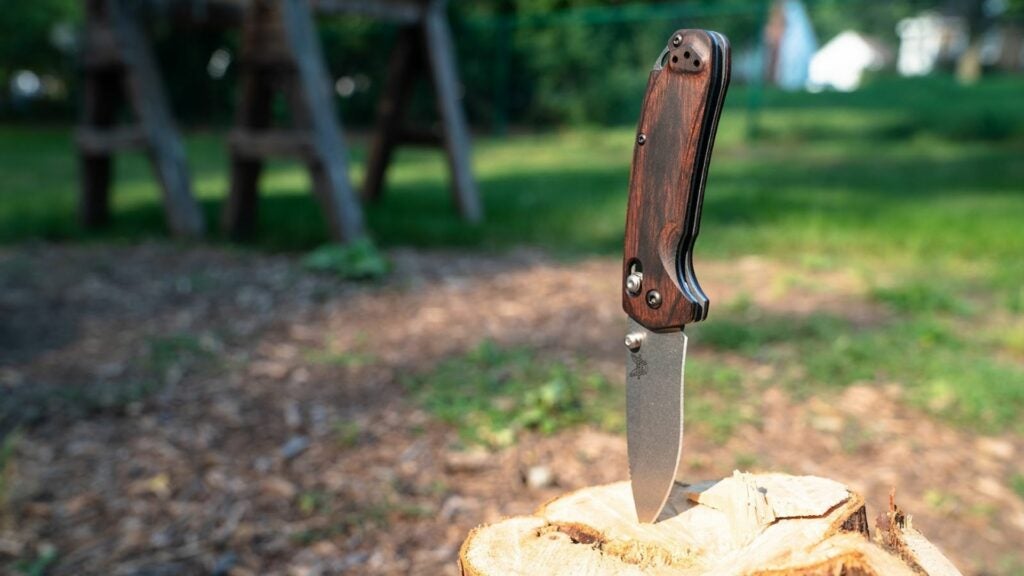
The blade and frame are equally tough. Benchmade uses CPM S30V stainless steel that’s known for its sharpness and ability to shed corrosives without enduring damage. Beveled edges make the handle smooth and easy to grip, and the action on the blade is addictingly light. The clip can be switched from side to side (but not end to end) with three screws. Sometimes thumb studs can require a deliberate push or even a repositioning of the hand (as in the case of my behemoth Ka-Bar Mule). Wrist-flicking is standard. The North Fork opens so easily and smoothly that it just took a little nudge from my thumb on the very first use.
How we tested the Benchmade North Fork
Just like any knife I test, the North Fork spent several days clipped to my pocket to make sure there was no rubbing, jabbing, or catching my hand when I grabbed my keys. The beautifully contoured handle kept the knife out of sight and out of mind, so you can feel good about using this for your EDC.
The North Fork did most of its work around my fire pit. I started by feathering some midsize sticks to help them light easier. Cutting into wood with this blade felt like slicing hard cheddar.
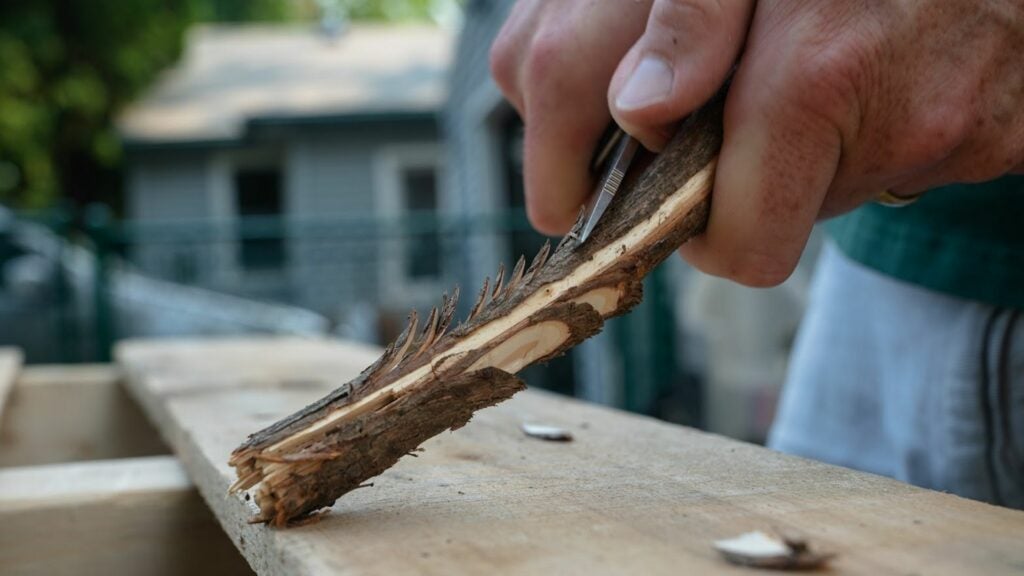
Because Benchmade markets the North Fork as a hunting knife, I needed to see how it handled raw meat. I didn’t have any conveniently timed and glamorous hunting vacations scheduled, so marinated sirloin had to suffice. Even though the edge of the North Fork was nowhere near the slim profile of a chef’s knife, it slid through the raw beef like a damn scalpel––pretty impressive for steel that thick.
My backyard grilling was significantly cleaner than dressing an animal in the field, but I figured the sticky soy glaze and cracked pepper were better than nothing. The North Fork’s locking mechanism was unfazed, although I’d still recommend a fixed-blade knife for heavy-duty hunting work. When I cleaned up, I noticed the handle lost its dark luster and looked more like untreated wood. Apparently, dish soap had washed away a protective coating, so I brought it back to life with the same kind of mineral oil I use on my cutting board. Chalk that up to the price you pay for a wooden handle––even if it is engineered.
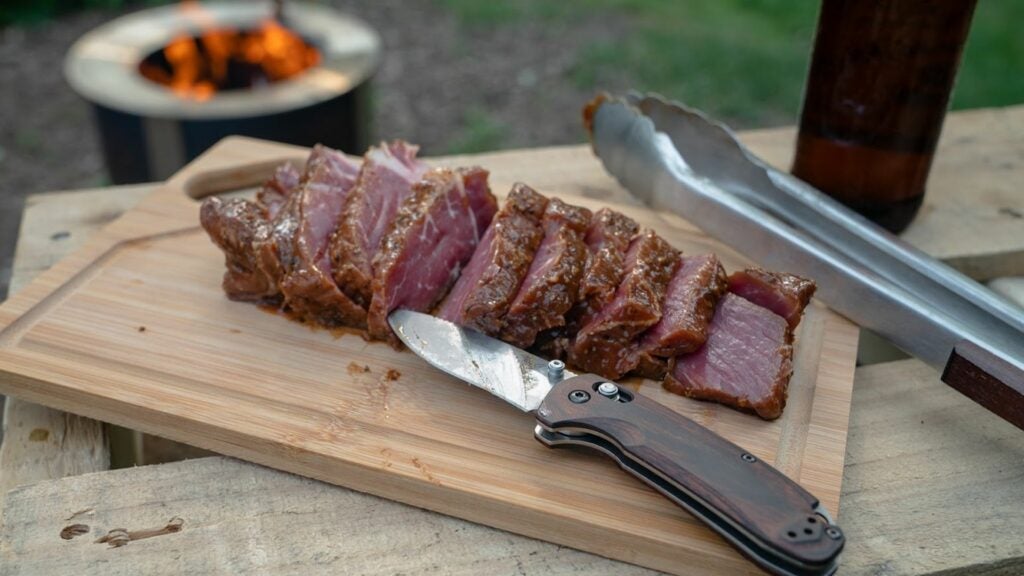
What we like about the Benchmade North Fork
There’s more than one way to evaluate folding knives, but the North Fork makes a pretty strong case for itself.
Look through our catalog of knife reviews, and you’ll see me and my fellow contributors examine things from value to durability to personal taste. Some aspects are universal, though. Above all else, if a knife isn’t sharp, it’s useless. According to my first impression metric, the North Fork comes in at a solid “holy shit” sharp. I’m talking about the kind of edge that sends a little tingle up my arm. Fit and finish are also damn good. The locking mechanism is smooth, the blade rotates effortlessly, and that Dymondwood handle looks money.
I have to rely on research and creative testing to evaluate long-term durability, and all indicators point to this knife being in it for the long run. I already mentioned the handle, which is bound to outlast any traditional wood handle and plenty of synthetic ones. The stainless steel used for the blade and frame inspires a lot of confidence not only in terms of durability but ease of ownership, too. If a knife can stay truly sharp with fewer trips to the whetstone, that’s fine by me.
This point is more subjective, but I think the styling of this knife has broad appeal. It’s more modern and innovative than a classic pocket knife without going full Rambo.
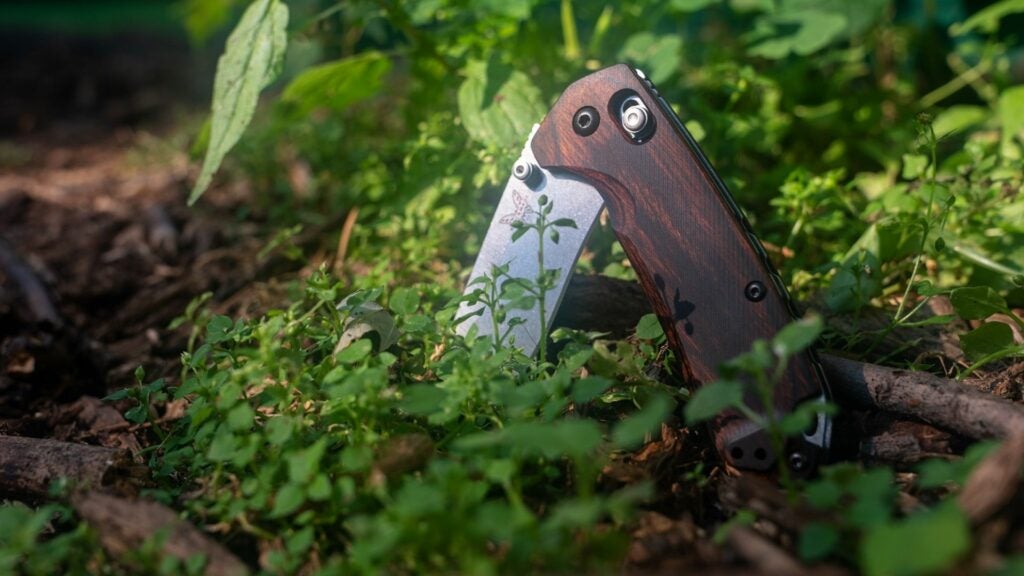
What we don’t like about the Benchmade North Fork
Thoughtful design makes the North Fork good at what it does, but there are drawbacks that come along with it.
If there’s one thing I can criticize about the North Fork, it’s the opening mechanism. Yes, it’s well-designed, well-built, and incredibly smooth. But it also incorporates a lot of very small moving components that are just waiting to be gummed up. Remember that this is a hunting knife, so the odds of coming into contact with gooey nastiness should be very high. I have to wonder how much abuse the locking mechanism can take before it gets jammed up and requires maintenance. A back-lock mechanism would be much simpler and significantly more durable, but it would come at the cost of this knife’s effortless high-end feel. I won’t fault Benchmade for this (and I wouldn’t change it), but it’s something to consider. I suspect it’s also why they recommend carrying a fixed blade alongside this knife.
Price is also a consideration. If you’re a hunter on a budget, it’s hard to justify a nearly $200 folding knife that requires you to buy a fixed-blade hunting knife, too. I’m inclined to think of this as a high-end EDC that can do light hunting duty when necessary.
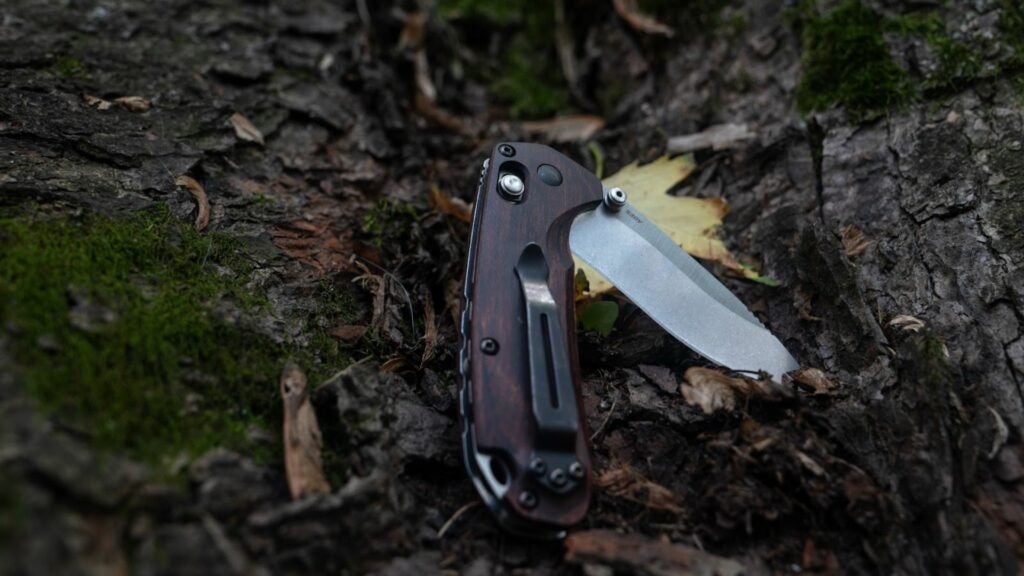
Verdict
I’m a big proponent of having tools for specific jobs. I also enjoy gear that has a sense of occasion about it. I’m obviously not the only one, if the number of knife and watch collectors out there is any indicator.
After a few weeks of using this particular Benchmade, it’s a knife I feel good about carrying. There’s just a sense of occasion that comes with sliding it into my pocket. The North Fork is marketed as a secondary hunting knife, and I would certainly trust it to back up a fixed-blade knife for cutting fishing line, dressing small game, and performing odd jobs around a campsite. I’d also be happy to use it as an EDC knife. The styling is timeless and functional. The steel is very good and I don’t mind oiling up the handle every so often.
One thing I wouldn’t use this knife for is anything tactical. It would get to stay home during deployment because it’s a little too shiny and way too small. I’d rather spend this kind of money on something built for more abuse if I were taking a knife into a combat zone.
Saved rounds
Competition in the knife market is serious. Manufacturers have to produce competitive products, but they should also help customers understand what makes their knives worth buying. There have been times in my various gear tests that I struggled to get specifics on certain manufacturers’ materials and production practices. Benchmade does a better job than most in the communication arena. That isn’t to say Benchmade is necessarily superior, but it inspires a higher level of confidence by letting customers know exactly what goes into making knives like the North Fork and telling epic stories like this one.
FAQs about the Benchmade North Fork
More questions? Here’s Task & Purpose’s additional brief.
Q. How much does the Benchmade North Fork cost?
A. Benchmade lists an MSRP of $190 for the North Fork. That seems reasonable, but I found it on sale for $161.99 at Walmart — even better.
Q. This knife is very pretty, but can it perform in harsh conditions?
A. The North Fork’s blade is made from CPM S30V steel. This type of steel achieves exceptional levels of edge retention and corrosion resistance by incorporating vanadium. It’s considered by many to be one of the best types of steel for knife-making.
The handle uses a type of engineered wood called Dymondwood. An intense process creates Dymondwood by combining layers of wood veneer with plastics with pressure and heat. The result isn’t indestructible, but it’s far stronger and requires less maintenance than natural wood.
So yes, this knife is built to survive.
Q. Are Benchmade knives worth the money?
A. Value is tough to quantify because it’s so subjective. Some people would never spend this kind of money on a pocket knife; others wouldn’t consider anything less. If you like to cycle through gear and keep your EDC changing on a regular rotation, this might be a bit much to spend on one piece. If you appreciate well-made equipment and intend to make this your primary folder, it’s worth the upcharge. Besides, you don’t have to pay MSRP to get one.
Q. Does Benchmade build their knives in the United States?
A. Sometimes. Benchmade labels each knife as “made in the USA,” “made in the USA with imported steel,” or skips any label at all. All knives are assembled in Oregon. The North Fork uses U.S. steel.
Q. Can a folding knife handle processing duties like a fixed-blade hunting knife?
A. Folding knives are super convenient, so it stands to reason that very few people would bother with a fixed blade if they performed the same. Benchmade even recommends carrying the North Fork in your pocket and a fixed blade in your pack when you go hunting or fishing. I have to agree; the North Fork is a fantastic folder, but there are times when you just need a full-sized blade. I’d field dress a bird or work calves with this knife, but I sure wouldn’t want to break down a moose with it.
We’re here to be expert operators in everything How-To related. Use us, compliment us, tell us we’ve gone full FUBAR. Comment below and let’s talk! You can also shout at us on Twitter or Instagram.
Scott Murdock is a Marine Corps veteran and contributor to Task & Purpose. He’s selflessly committed himself to experience the best gear, gadgets, stories, and alcoholic beverages in the service of you, the reader.
Task & Purpose and its partners may earn a commission if you purchase a product through one of our links. Learn more about our product review process.
